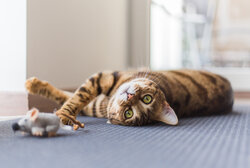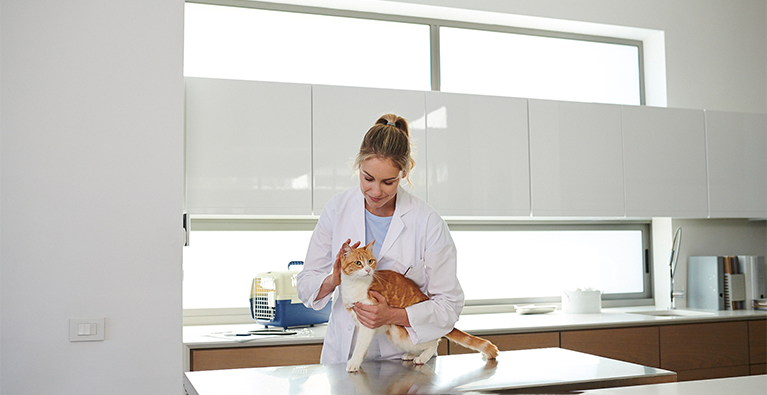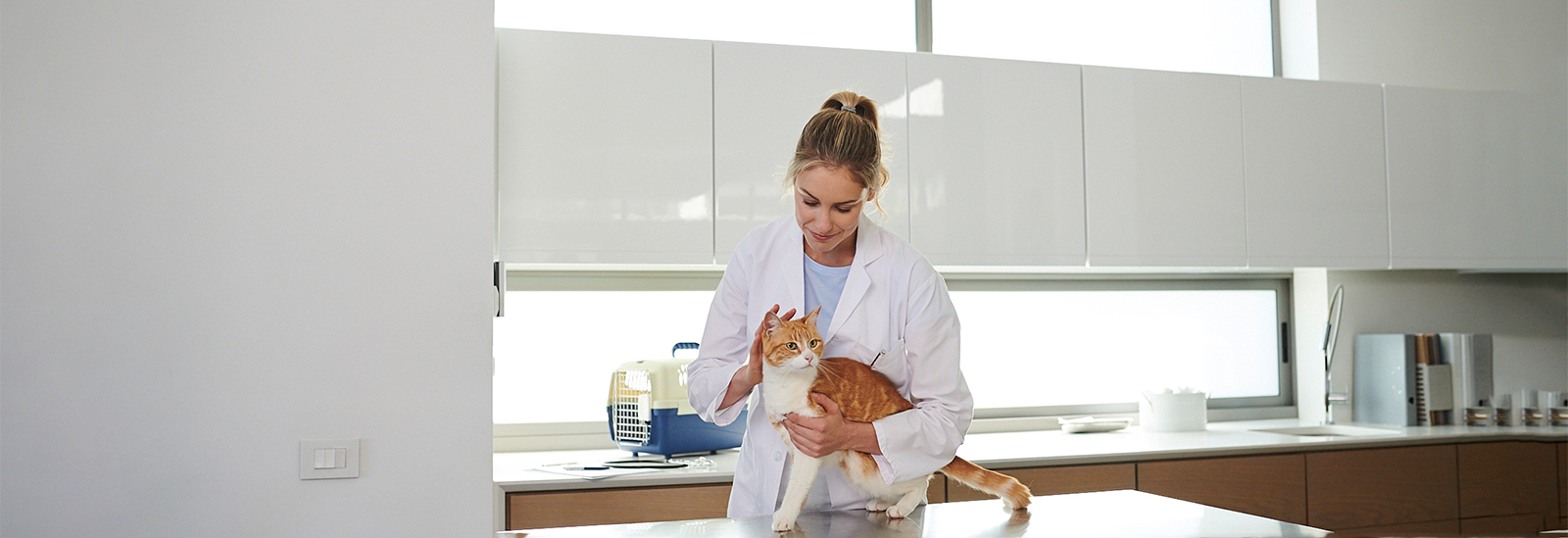My cat is scared of going to the vet
Although it is not uncommon for cats to feel anxious when visiting the vet, some simple precautionary measures can be taken to prevent your pet panicking. We have put together a few tips to make your next visit to the vet a more stress-free experience.
Taking your cat to the vet
When you talk to cat owners about their visits to the vet, you will hear a wide variety of different stories. Some will have had hardly any problems at all, while others may have found visiting the vet to be a real ordeal: when some cats see the carrying box, they run and hide as far away as possible. Catching them can therefore be a major challenge. The cat, already under a great deal of stress, then has to endure a car journey and may have to face a crowded waiting room before the appointment with the vet. To the cat’s displeasure, the vet then even dares to touch it, causing hissing and scratching. Back at home, the pet will be upset for days on end and you can only hope that no new appointment will be necessary any time soon. However, a visit to the vet does not have to be this stressful. There are plenty of ways to make it a more stress-free experience!
What should I do if my cat refuses to go into the carrying box?
To take a cat safely to the vet, the use of a carrying box is recommended. This should, however, not be suddenly brought out of storage an hour before the appointment .If your cat has a timid nature, it is best to make use of the box all year round or at least at regular intervals: use the box as an additional place for your cat to snuggle up in. Equip it with a blanket and toys and hide a treat in it from time to time. Leave the lid or door of the box open so that your cat can go in and out whenever it pleases and gradually become accustomed to it.
Especially with kittens, it is well worth getting them used to the box right from the start. It should become a familiar item of furniture with which your cat has positive associations. You should therefore always praise your pet when it goes inside voluntarily. This is also the ideal time to close the flap every now and then. At first only for a few seconds, then for an increasingly longer amount of time. If this works, the next step is to carry your cat around your home in the closed box. Do not forget to give your pet a reward and gradually increase the length of time.
Travelling with your cat in the car
When your cat is becoming more and more accustomed to the box, occasionally take it all the way to the car. Fasten the box securely to the back seat and, depending on the situation, decide whether this is enough for now or whether you want to take your pet for a short drive. Under no circumstances should your cat’s first trip in the car be to the vet. Just take your pet for a short drive and then carry it back into your home. Even if this may seem somewhat strange to you, besides getting used to the box, a problem-free car ride is one of the most important ways of ensuring a stress-free visit to the vet.
Preparing your cat for the visit to the vet
Some cats do not like to be touched by the vet at all. This is partly because the person is a stranger, but also because of the unfamiliar nature of the physical contact. The vet will want to look into your cat’s mouth and ears, and perhaps to feel its tummy or lift up its tail. Your pet will not be used to any of this. It is therefore advisable to occasionally rehearse this with your cat and to then give it a reward. This will certainly be appreciated by the vet.
Vets will usually be happy for you to take your cat for a trial visit and to sit in the waiting room for ten minutes or so. Perhaps there will even be time for you to take your pet into the consulting room for a few minutes. Anything that a cat has already experienced and does not immediately associate with something negative can be a great advantage for a future visit to the vet.
A well organised trip to the vet
You should also never underestimate the influence that you yourself have on your cat. If you drive to the vet in a disorganised and hurried way, then you should not be surprised if your cat takes on your own tense mood. It is therefore important to prepare everything well in advance. Have your cat’s vaccination certificate and any other necessary documents ready, have plenty of treats at hand, get the carrying box ready and do not set off at the last minute. Do everything calmly and allow plenty of time for everything. Remain relaxed and do not show any visible sympathy for your cat because of the upcoming visit. Sensitive cats may well become nervous as a result of any excessive affection. Try to avoid making a big deal out of visiting the vet.
Visiting the vet
If you know that your cat is anxious about going to the vet, then avoid open surgery sessions and make a fixed appointment. The best time for this is first thing in the morning. The advantage is that the waiting room will still be empty and will not be filled with the many smells that accumulate during the day. In addition, it is more likely that you will not have to wait long. If, however, there are already other pet owners in the waiting room, choose a spot that is as secluded as possible and do not place the carrying box on the floor, but on a chair next to you or on your lap.
For visits to the vet, it is best not to use a wicker basket, but a plastic carrying box that can be opened at the front and top. It may even be possible for the cat to stay in the box during the examination, and it will be easier for you to take out your cat if necessary. Should your pet jump off the table and hide in a corner, you should not attempt to get hold of it as quickly as possible. Try to do this calmly, to avoid the level of stress becoming so severe that any further examination is impossible. Perhaps the vet will be able to examine your cat on your lap. However, this does not always work, so it is important to get your pet used to as many situations as possible associated with a visit to the vet.
Tip: For anxious cats, it may be worth using a pheromone product in the form of a spray. Spray the carrying box half an hour before setting off. Many cats respond very positively to the stress-relieving fragrance.
You may also like this

Keeping cats occupied
Useful ideas for keeping cats occupied

Getting your cat used to being outdoors
This is how you get your cat used to being outdoors

Getting cats used to each other
This is how you successfully get cats used to each other

When cats no longer get on
These are possible reasons

